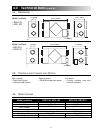
14
6.0 Installation (cont’d)
a) Follow the instructions in Section 6.4 below to determine the appropriate duct diameters for your system.
b) Keep it simple. Plan for a minimum number of bends and joints. Keep the length of insulated duct to
a minimum.
c) Do not use wall cavities as ducts. Do not use branch lines smaller than 4” (102 mm) Ø.
d) Do not ventilate crawl spaces or cold rooms. Do not attempt to recover the exhaust air from a dryer or
a range hood. This would cause clogging of the recovery module. Use sheet metal for the kitchen
exhaust duct.
e) Be sure to plan for at least one exhaust register on the highest lived-in level of the house if it has
2 floors or more.
Use the table below to ensure that the ducts you intend to install will be carrying air flows at or
under the recommended values. Avoid installing ducts that will have to carry air flows near the
maximum values and never install a duct if its air flow exceeds the maximum value.
NOTE: Examples 6.4.1 and 6.4.2 use imperial measures.
The same calculation applies to metric measures.
6.4.1 Example of calculation:
Problem: My installation requires two exhaust registers (one for the kitchen, one for the bathroom).
I will connect these registers to a main duct which will connect to the unit (high speed performance
value of 140 cfm). What size of duct should I use for the main exhaust duct and for the two end
branches leading to the registers? (See figure 8.)
Solution: Simplified method.
(For a more detailed method of calculating duct size refer to the
ASHRAE or HRAI HANDBOOK).
Main duct:
Table above indicates a 6” Ø duct: recommended air flow: 120 cfm; maximum air flow:
180 cfm. The high speed air flow of 140 cfm is close enough to the recommended value (120) and
far enough away from the maximum value (180). Therefore a 6ӯ duct or larger is an appropriate
choice for the main exhaust duct.
End branches: Each end branch will have to transport an air flow of 70 cfm (140 divided by 2). Table
above indicates a 5ӯ duct: recommended air flow: 75 cfm; maximum air flow: 110 cfm. The high
speed air flow of 70 cfm is close enough to the recommended value (75) and far enough away
from the maximum value (110). Therefore a 5ӯ duct or larger is an appropriate choice for the
2 end branches
.
NOTE: A 4ӯ duct would have been too small because the maximum acceptable value for a 4ӯ
duct is 60 cfm.
6.3 PLANNING OF THE DUCTWORK
6.4 CALCULATING THE DUCT SIZE
VI0003
end
branches
main branch
6”ø 140 cfm
5”ø
70 cfm
4”(102 mm) 40 cfm 19 l/s 68 m
3
/h 60 cfm 28 l/s 102 m
3
/h
5”(127 mm) 75 cfm 35 l/s 127 m
3
/h 110 cfm 52 l/s 187 m
3
/h
6”(152 mm) 120 cfm 57 l/s 204 m
3
/h 180 cfm 85 l/s 306 m
3
/h
7”(178 mm) 185 cfm 87 l/s 314 m
3
/h 270 cfm 127 l/s 459 m
3
/h
8”(203 mm) 260 cfm 123 l/s 442 m
3
/h 380 cfm 179 l/s 645 m
3
/h
Duct Recommended Maximum
Diameter Air Flow Air Flow
figure 8
140 cfm


















